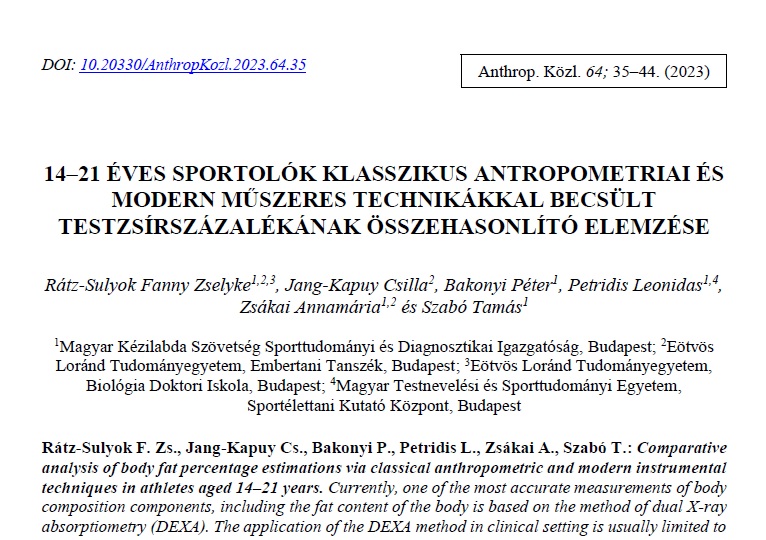Comparative analysis of body fat percentage estimations via classical anthropometric and modern instrumental techniques in athletes aged 14–21 years
Abstract
Currently, one of the most accurate measurements of body composition components, including the fat content of the body is based on the method of dual X-ray absorptiometry (DEXA). The application of the DEXA method in clinical setting is usually limited to the assessment of bone health status due to the device’s cost and immobile nature, therefore in sport diagnostics the body composition estimation is usually carried out with other methods, such as bioimpedance analysis or anthropometrical methods based on the measurement of body dimensions, which ensure a rapid, accurate and frequently repeatable way of examination.
For our research goal we choose the comparison of the most frequently used body fat percentage estimation methods. The accuracy of the other methods in the light of the DEXA estimations is presented. Sport Sciences and Diagnostic Research Centre of the Hungarian Handball Federation coordinated the assessment of 171 young elite handball players (14–21-year-olds), whose body composition estimations were performed in the spring and summer of 2023.
The preliminary analysis of body fat percentage estimates in handball players carried out with different methods showed that the rapid and cost-efficient estimations based on anthropometric skinfold measurements can substitute the body fat percentage estimation method based on the clinically acclaimed golden standard dual X-ray absorptiometry technology. Body fat percentage estimation via InBody 770 device showed significantly lower values compared to the DEXA method, however this difference was consistent, therefore body composition assessment via InBody device can serve as an alternative of monitoring personal progress and status. We also carried out examinations with a novel ultrasound technology aided by BodyMetrix device, its subcutaneous fat thickness measurement estimated accurately the skinfold thicknesses on human body, its body fat percentage estimation based the skinfold thicknesses was adequately accurate compared to the DEXA method.
With the aid of available DEXA measurement results and with the aim of creating an alternative method with low instrument requirement for body fat percentage estimation, which can be used with the highest accuracy particularly considering the body composition of young elite athletes, we created a modified sport-specific body fat percentage estimation equation. Our new estimation method was based on classical anthropometric skinfold measurements, and it accurately correlated with the DEXA body fat% estimates in case of young elite handball players.
References
Albanese, C.V., Diessel, E., Genant, H.K. (2003): Clinical applications of body composition measurements using DXA. Journal of Clinical Densitometry, 6: 75–85. DOI: https://doi.org/10.1385/JCD:6:2:75
Andreoli, A., Garaci, F., Cafarelli, F. P., Guglielmi, G. (2016): Body composition in clinical practice. European Journal of Radiology, 85: 1461–1468. DOI: https://doi.org/10.1016/j.ejrad.2016.02.005
Antonio, J., Kenyon, M., Ellerbroek, A., Carson, C., Tyler-Palmer, D., Burgess, V., Angeli, G., Silver, T., Jiannine, L., Peacock, C. (2019): Body Composition Assessment: A Comparison of the Bod Pod, InBody 770, and DXA. Journal of Exercise and Nutrition, 2: 11. https://www.journalofexerciseandnutrition.com/index.php/JEN/article/view/44
Bazzocchi, A., Ponti, F., Albisinni, U., Battista, G., Guglielmi, G. (2016): DXA: Technical aspects and application. European J. of Radiology, 85: 1481–1492. DOI: https://doi.org/10.1016/j.ejrad.2016.04.004
Bilsborough, J.C., Greenway, K., Opar, D., Livingstone, S., Cordy, J., Coutts, A.J. (2014): The accuracy and precision of DXA for assessing body composition in team sport athletes. Journal of Sports Sciences, 32: 1821–1828. DOI: https://doi.org/10.1080/02640414.2014.926380
Dimai, H.P. (2017): Use of dual-energy X-ray absorptiometry (DXA) for diagnosis and fracture risk assessment; WHO-criteria, T- and Z-score, and reference databases. Bone, 104: 39–43. DOI: https://doi.org/10.1016/j.bone.2016.12.016
Lee, D.H., Giovannucci, E.L. (2018): Body composition and mortality in the general population: A review of epidemiologic studies. Experimental Biology and Medicine, 243: 1275–1285. DOI: https://doi.org/10.1177/1535370218818161
Lewiecki, E.M., Binkley, N. (2017): DXA: 30 years and counting: Introduction to the 30th anniversary issue. Bone, 104: 1–3. DOI: https://doi.org/10.1016/j.bone.2016.12.013
Lozano-Berges, G., Matute-Llorente, A., Gomez-Bruton, A., Gonzalez-Aguero, A., Vicente-Rodriguez, G., Casajus, J.A. (2019): Accurate prediction equation to assess body fat in Male and female adolescent football players. International Journal of Sport Nutrition and Exercise Metabolism, 29: 297–302. DOI: https://doi.org/10.1123/ijsnem.2018-0099
McLester, C.N., Nickerson, B.S., McLester, J.R. (2020): Reliability and agreement of various Inbody body composition analysers as compared to dual-energy x-ray absorptiometry. Journal of Clinical Densitometry, 23: 443–450. DOI: https://doi.org/10.1016/j.jocd.2018.10.008
Nana, A., Slater, G.J., Stewart, A.D., Burke, L.M. (2015): Methodology review: Using dual-energy X-ray absorptiometry (DXA) for the assessment of body composition in athletes and active people. International Journal of Sport Nutrition and Exercise Metabolism, 25: 198–215. DOI: https://doi.org/10.1123/ijsnem.2013-0228
Shepherd, J.A., Ng, B.K., Sommer, M.J., Heymsfield, S.B. (2017): Body composition by DXA. Bone, 104: 101–105. DOI: https://doi.org/10.1016/j.bone.2017.06.010
Slaughter, M.H., Lohman, T.G., Boileau, R.A., Horswill, C.A., Stillman, R.J., Loan, M.D., Bemben, D.A. (1988): Skinfold equations for estimation of body fatness in children and youth. Human Biology, 60: 709–723. https://pubmed.ncbi.nlm.nih.gov/3224965
Ulbricht, L., Neves, EB., Ripka, W.L., Romaneli, E.F.R. (2012): Comparison between body fat measurements obtained by ultrasound and caliper in young adults. Annual International Conference of the EMBS, 2012: 1952–1955. DOI: https://doi.org/10.1109/EMBC.2012.6346337
Weiner, J.S., Lourie, J.A. (1969): Human Biology, A Guide to Field Methods. Blackwell Sci., Oxford.




